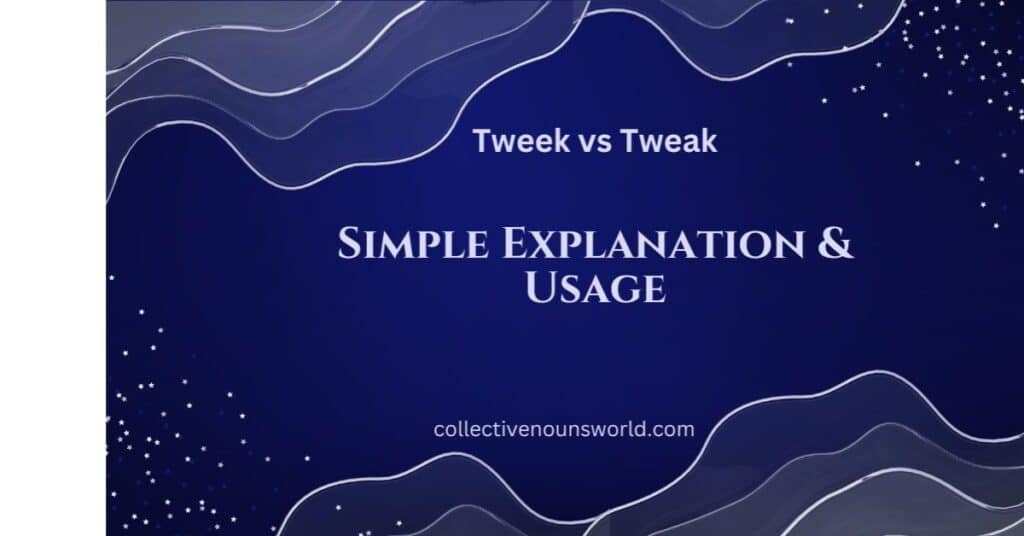In the world of language, even the smallest differences in spelling can change everything. “Tweek” and “tweak” are often confused, but they hold distinct meanings that can lead to completely different interpretations.
While “tweak” refers to making small adjustments or improvements, “tweek” is an uncommon variant that typically refers to something much more specific and is often associated with a slang term.
Understanding the subtle differences between these two words is essential for mastering both casual and formal conversations. Let’s dive into the nuances of these terms and uncover what sets them apart in language.
Understanding Tweek and Tweak
Language evolves, and so do its nuances, leading to common mix-ups like “tweek” and “tweak.” While the terms may appear similar, their meanings and proper usage differ significantly. “Tweak” is the correct word, widely recognized for describing minor adjustments or improvements. On the other hand, “tweek” is often simply a misspelling or typographical error. Recognizing this distinction helps maintain clarity and precision in communication, especially in writing. Let’s explore how these terms are used and understood in various contexts.
Accurate spelling not only conveys professionalism but also ensures your message is interpreted as intended. Misusing words can lead to confusion or diminish credibility, which is why it’s vital to differentiate between “tweek” and “tweak.” Whether you’re editing a project, troubleshooting a problem, or learning new vocabulary, understanding these terms can refine your skills.
Tweek: Definition and Usage
“Tweek” doesn’t hold an official definition in standard English; instead, it represents a common misspelling of “tweak.” You might find “tweek” used casually in informal text messages, online forums, or social media posts, often as a result of haste or autocorrect errors. For example, someone might write, “I need to tweek my resume” when they actually mean “tweak.” While it’s easy to overlook in informal contexts, using “tweek” in professional writing can undermine your message’s impact.
Tweak: Definition and Usage
The word “tweak” carries a clear and practical meaning: to make slight adjustments or refine something to improve its functionality or performance. This term is versatile and commonly used in both personal and professional settings. For example, in a casual context, you might say, “I tweaked the recipe by adding more spices.” In a professional environment, it’s often used in phrases like, “We need to tweak the software for better performance.” Understanding its correct usage not only boosts communication skills but also ensures your writing remains polished and precise.
Side-by-Side Comparison
Understanding the difference between “tweek” and “tweak” is easier when presented visually. The table below highlights their distinctions in meaning, usage, and common errors:
| Aspect | Tweek | Tweak |
| Meaning | No official meaning; a misspelling | To make small adjustments or modifications |
| Usage | Informal errors in casual contexts | Used in everyday and professional communication |
| Examples | “I need to tweek this document.” | “I need to tweak this document.” |
| Recognition | Not found in standard dictionaries | Standard English term, widely recognized |
The distinction is straightforward: one is incorrect, while the other is an established part of the language.
You may also like: Simpler or More Simple: Grammar Rules Made Easy
Everyday Usage Examples
The term “tweak” is versatile, fitting into many everyday scenarios. Here are some examples of its usage:
- Tweaking a recipe: “I tweaked the soup recipe by adding more garlic for extra flavor.”
- Adjusting a plan: “Let’s tweak the project timeline to fit the new deadline.”
- Modifying settings: “I tweaked the brightness on my phone for better visibility.”
In each case, “tweak” represents a minor but impactful adjustment, showcasing its practicality and relevance.
What Is the Difference Between Tweek and Tweak?
The primary difference between “tweek” and “tweak” lies in accuracy and recognition. “Tweak” is a legitimate word, widely accepted and used to describe small refinements, while “tweek” is simply a misspelling. Correct spelling matters because it enhances your credibility and ensures effective communication.
Tweak: The Correct Word
“Tweak” is the proper spelling, found in dictionaries and widely used in both casual and formal contexts. Its versatility makes it valuable for discussing anything from small edits to significant refinements.
Tweak Definition
The word “tweak” means to make slight changes or adjustments to improve something. Originating from Middle English, it initially referred to pinching or pulling before evolving into its modern usage of minor modifications.
Tweak Usage in Everyday Context
Examples of “tweak” abound in daily life:
- Editing a document: “I need to tweak the wording in this paragraph to make it clearer.”
- Improving a process: “We tweaked our workflow to save time and resources.”
- Fine-tuning settings: “You can tweak the audio settings for a better experience.”
Using “tweak” appropriately can convey precision and professionalism.
Tweek: The Misspelling
“Tweek” is not a recognized word in standard English. It often appears due to typos, autocorrect errors, or a lack of familiarity with the correct spelling. While it might be overlooked in informal writing, avoiding “tweek” in academic and professional settings is crucial for maintaining credibility. Opting for “tweak” ensures your writing is polished and authoritative.
You may also like: Potatoes or Potatos: Which One Is Right?
Why Does the Confusion Between Tweek and Tweak Occur?
The mix-up between “tweek” and “tweak” is surprisingly common and stems from several factors. Despite their identical pronunciation, their spellings carry different meanings. Factors like phonetic similarity, autocorrect missteps, and gaps in education or familiarity with the correct term contribute to this confusion. Understanding these causes can help prevent errors in both casual and formal communication.
Phonetic Confusion
When spoken, “tweek” and “tweak” sound almost identical, making it easy for people to mistake one for the other while writing. This phonetic similarity is a common issue in English, especially for words that differ by only a single letter or vowel sound.
Autocorrect Errors
Modern technology can sometimes cause as many problems as it solves. Autocorrect systems, designed to assist with spelling, may mistakenly suggest or accept “tweek” as the correct form. This is especially true in fast-paced typing environments where users might not double-check their words.
Educational Gaps
Spelling nuances aren’t always emphasized in less formal educational settings or during casual writing. If someone encounters the incorrect form “tweek” in texts or online, they might assume it’s correct and continue using it without further verification.
Examples of “Tweak” in Professional Writing
“Tweak” plays a critical role in professional communication, where small adjustments can significantly improve clarity, functionality, and outcomes. Below are examples of how the term is used across various industries:
Business Communication: Refining a Proposal
In business settings, tweaking a proposal can make it more compelling. For instance, “After reviewing client feedback, we tweaked the proposal to highlight cost-saving measures.” This process often involves fine-tuning language, structure, or data presentation to align with the target audience’s preferences.
Graphic Design: Small Adjustments
Graphic designers frequently tweak their projects to achieve the perfect balance of aesthetics and usability. For example, “The designer tweaked the font size and color palette to enhance readability on mobile screens.”
Technology and Software Updates
In technology, tweaking refers to making minor code or interface adjustments to improve functionality or address bugs. For instance, “The development team tweaked the app’s performance to reduce loading times by 30%.”
Personal Productivity: Making Fine-Tuned Changes
Tweaking productivity tools or habits can lead to meaningful improvements in efficiency. For example, “I tweaked my daily schedule to prioritize high-energy tasks in the morning, resulting in better focus and output.” Small adjustments often deliver disproportionately large benefits over time.
Common Synonyms for Tweak
“Tweak” has several synonyms that convey similar meanings, depending on the context. These include:
Adjust: Often used for small changes to improve functionality or fit.
Modify: Implies altering something slightly to suit specific needs.
Fine-tune: Focuses on making precise improvements for optimal results.
Alter: Suggests a broader change that may or may not be minor.
Refine: Indicates polishing or enhancing something to a higher standard.
Each of these words can substitute for “tweak” while maintaining clarity, giving writers flexibility in their phrasing.
You may also like: IHH Meaning in Text: Simple Guide & Examples
Why Spelling Accuracy Matters
Correct spelling is essential in all forms of communication, especially in professional and academic writing. Misspelling words like “tweak” as “tweek” can lead to misunderstandings, undermine credibility, and damage the writer’s reputation. Using accurate language shows attention to detail and ensures messages are clearly and effectively conveyed.
The Impact of Spelling Errors
1. Professionalism
Accurate spelling reflects a polished and professional image, which is especially important in formal settings like job applications, business proposals, or academic essays. Errors can make the writer seem careless or unprepared.
2. Clarity and Communication
Correct spelling ensures readers understand the intended meaning. Mistakes like “tweek” instead of “tweak” may cause confusion, diverting attention from the actual message.
3. Reputation and Credibility
Consistently accurate spelling builds trust and credibility, demonstrating that the writer values precision and quality. Persistent errors can erode confidence in the writer’s expertise or competence.
H3-Tips to Ensure Spelling Accuracy
1. Proofread Thoroughly
Take time to carefully read through your work before submitting or sharing it. A fresh set of eyes often catches mistakes overlooked during initial writing.
2. Use Spelling Tools
Leverage tools like spell-check software to identify and correct errors. While these tools aren’t infallible, they’re excellent for catching basic typos.
3. Learn Commonly Confused Words
Familiarize yourself with frequently mixed-up terms, such as “tweak” and “tweek,” to reduce errors in your writing.
4. Ask for a Second Opinion
Ask a trusted colleague, friend, or editor to review your work. Another perspective can highlight mistakes you may have missed.
5. Stay Updated
Language evolves, and keeping up with current spelling conventions helps you maintain clarity and modern relevance in your writing. Regularly consulting dictionaries or style guides can keep your skills sharp.
The Importance of Small Changes in Professional Writing
In professional writing, even the smallest adjustments can have a significant impact on the clarity and effectiveness of communication. A single phrase or sentence tweak can transform an unclear idea into a powerful, engaging message. Paying attention to these fine details ensures that writing not only communicates the intended message but also leaves a lasting impression on readers.
Why Small Changes Matter
1. Clarity and Precision
Small tweaks, like restructuring a sentence or replacing vague words with specific ones, can make ideas sharper and more comprehensible. For example, “The report is kind of long” becomes more precise when rephrased as, “The report exceeds the preferred length by 10 pages.”
2. Professionalism
Refining language to eliminate errors, awkward phrasing, or redundancy elevates the professionalism of your writing. For instance, a polished email with well-chosen words shows respect for the recipient’s time and intelligence.
3. Tone and Engagement
Adjusting tone through minor word changes can make writing more engaging and suited to the target audience. For example, replacing stiff language like “It is advised” with “We recommend” can make the message feel friendlier and more direct.
You may also like: Top 20 Jamaican Slang for Friend or Bro
Practical Tips for Refining Professional Writing
Achieving polished writing requires deliberate effort and attention to detail. These practical tips can help writers refine their work:
1. Review and Revise Thoroughly
Set aside time to revisit your work multiple times. Focus on structure, clarity, and flow during each pass to identify areas for improvement.
2. Seek Constructive Feedback
Another perspective often reveals blind spots. Share your work with a trusted colleague or friend who can offer objective feedback on areas that may need tweaking.
3. Use Advanced Editing Tools
Tools like Grammarly or Hemingway Editor can highlight errors, suggest improvements, and help refine the tone and readability of your writing.
4. Read Your Work Aloud
Hearing your words can help you detect awkward phrasing, redundant sentences, or unclear sections that you might miss when reading silently.
5. Focus on Audience Needs
Tailor your tweaks to align with the audience’s expectations. Whether simplifying jargon or using a more conversational tone, keeping your audience in mind ensures your writing resonates effectively.
Key Takeaways on Tweek vs. Tweak: Why Precision Matters
Accuracy in language is key to effective communication. While “tweek” is a common misspelling, “tweak” is the correct term used to describe small adjustments or refinements. Using “tweak” appropriately demonstrates professionalism, enhances clarity, and ensures your message is understood.
What Is the Difference Between “Tweek” and “Tweak”?
The difference lies in correctness. “Tweek” is an error, while “tweak” refers to making minor changes to improve or perfect something. By prioritizing precision in writing, you can maintain credibility and professionalism in all forms of communication.
FAQs
Is “tweek” ever an acceptable spelling?
No, “tweek” is not standard English but may appear in informal contexts or as a typo.
Is it spelled tweek or tweak?
The correct spelling is “tweak.”
What does tweek mean in slang?
In slang, “tweek” can refer to erratic behavior, often associated with drug use.
Does tweak mean to adjust?
Yes, “tweak” means to make slight adjustments for improvement.
What does the phrase tweak mean?
It refers to fine-tuning or modifying something slightly to enhance it.
Conclusion
spreading kindness and positivity can have a big impact on the world. Simple acts of kindness can brighten someone’s day and encourage others to do the same. By focusing on the good in people and situations, we create a supportive environment that nurtures growth and happiness.
Remember, even small gestures matter. A smile, a thoughtful word, or a helping hand can make a difference. Let’s keep spreading positivity and kindness, as it leads to a more connected and loving world for all.

Luna Jasper is an experienced blogger with a passion for language and grammar. At **Collective Nouns World**, she shares her expertise in exploring the fascinating world of collective nouns, making learning both engaging and fun. With years of writing and research under her belt, Luna’s insightful articles help readers understand and appreciate the English language.







